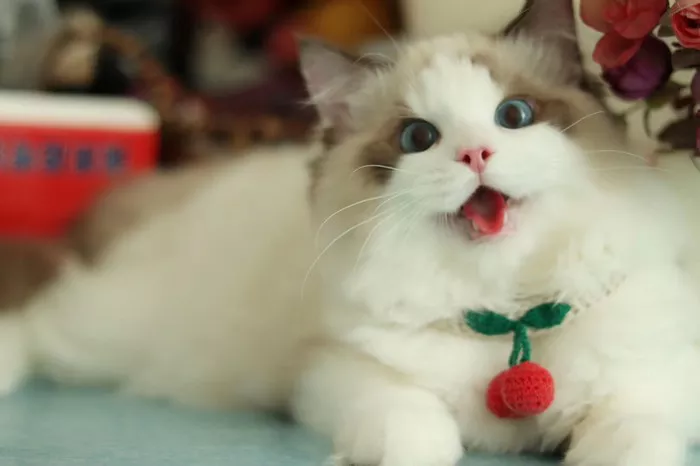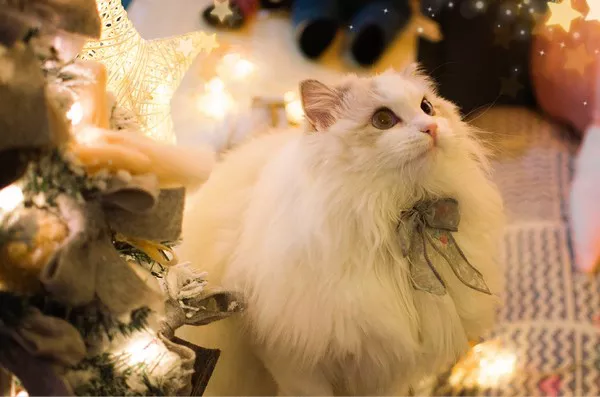Ragdoll cats, with their striking blue eyes and placid demeanor, are known for their captivating appearance and gentle nature. However, there may be moments when owners notice a peculiar phenomenon – the transformation of their Ragdoll cat’s eyes into a mesmerizing shade of red. While it may be unsettling to witness, this occurrence is not a cause for alarm. In this article, we will delve into the intriguing world of Ragdoll cats and explore the reasons behind why their eyes may turn red, shedding light on the science, genetics, and potential factors contributing to this unique phenomenon.
The Enchanting Eyes of Ragdoll Cats
1. Distinctive Blue Eyes: Ragdoll cats are renowned for their large, vivid blue eyes, which contribute significantly to their overall allure. These eyes are a key feature of the breed standard and are one of the reasons why Ragdolls are considered some of the most visually striking feline companions.
2. Color Points: Ragdoll cats typically exhibit a color-point pattern, characterized by a lighter body color with darker points on the ears, face, paws, and tail. The contrast between the body color and the darker points enhances the visual impact of their eyes, drawing attention to their deep blue gaze.
3. Variations in Eye Color: While blue eyes are the most common and sought-after eye color in Ragdoll cats, there can be some variations. Some Ragdolls may have blue-green or aqua eyes, adding to the diversity within the breed. However, the emergence of red eyes is not a standard or desired trait in Ragdoll cats.
Understanding the Phenomenon
1. Photoreceptor Cells and Eye Color: The color of a cat‘s eyes is determined by the presence and distribution of pigments in the iris. In the case of Ragdoll cats, the blue eye color is a result of the scattering of light by specialized cells in the iris. This scattering phenomenon, known as Tyndall scattering, is responsible for the stunning blue hue observed in their eyes.
2. Absence of Red Pigments: Unlike some other animals, cats, including Ragdolls, lack red pigments in their eyes. The absence of red pigments contributes to the dominance of blue tones. The genetic factors that regulate eye color in cats involve the presence of melanin, which is responsible for the darker colors observed in the points of Ragdoll cats.
3. Reflective Tapetum Lucidum: Another factor influencing the appearance of a cat’s eyes, including Ragdolls, is the tapetum lucidum – a layer of cells in the retina that enhances night vision by reflecting light. The tapetum lucidum often contributes to the characteristic “shine” seen in a cat’s eyes in low-light conditions but does not play a direct role in the red-eye phenomenon.
The Mystery of Red Eyes in Ragdoll Cats
1. Photoreceptor Cells and Light Sensitivity: The intriguing transformation of Ragdoll cat eyes into a reddish hue is primarily associated with the sensitivity of their photoreceptor cells to specific wavelengths of light. While Ragdolls lack red pigments, their eyes may appear red under certain lighting conditions due to the interaction between light and the structure of the eye.
2. Phototoxicity and Blood Vessels: The red-eye phenomenon in Ragdoll cats can be linked to phototoxicity, a condition where the eyes are exposed to excessive light. In some cases, ambient light may cause the blood vessels in the eyes to become more apparent, giving the eyes a reddish tint. This is particularly noticeable in low-light conditions or when light is reflected directly into the eyes.
3. Common Occurrence in Photography: The red-eye effect is a well-known occurrence in flash photography, where the flash reflects off the retina’s blood vessels. While humans often experience red-eye in photographs, cats, including Ragdolls, may exhibit a similar effect due to the reflective tapetum lucidum and the sensitivity of their eyes.
Factors Contributing to Red Eyes in Ragdoll Cats
1. Genetic Factors: The genetic makeup of Ragdoll cats can influence the likelihood of red-eye occurrence. While not a standard trait, certain genetic variations or combinations may make some Ragdolls more prone to displaying red eyes under specific lighting conditions.
2. Age and Health Factors: Younger cats, including Ragdoll kittens, may be more susceptible to the red-eye phenomenon due to the structure and development of their eyes. Additionally, underlying health conditions affecting the eyes, such as inflammation or irritation, may contribute to increased red-eye visibility.
3. Environmental Lighting: The color and intensity of ambient lighting play a crucial role in the appearance of red eyes in Ragdoll cats. Natural sunlight, artificial lighting, or even the use of flash photography can influence how the eyes reflect and appear to the observer.
4. Photography Techniques: Specific photography techniques, such as the use of certain camera settings or capturing images in low-light conditions, can enhance the red-eye effect in photographs of Ragdoll cats. The reflective properties of the tapetum lucidum, combined with the cat’s eye structure, contribute to this optical illusion.
Addressing Concerns and Best Practices
1. Regular Veterinary Checkups: While the red-eye phenomenon in Ragdoll cats is generally harmless, it’s essential to prioritize regular veterinary checkups to ensure the overall health and well-being of your feline companion. Any changes in eye color, excessive tearing, or signs of discomfort should be promptly addressed by a veterinarian.
2. Eye Irritation and Inflammation: Red eyes in Ragdoll cats may also be a sign of underlying eye irritation or inflammation. Common causes include allergies, infections, or foreign objects in the eyes. If your cat displays persistent red eyes or signs of discomfort, seek professional veterinary advice for a thorough examination.
3. Prevent Overexposure to Light: To minimize the likelihood of red eyes in Ragdoll cats, particularly in photographs, consider avoiding direct flash photography or using diffused lighting techniques. Additionally, providing shaded areas or dimming lights in the environment can reduce the intensity of light exposure.
4. Promoting Eye Health: Incorporate practices that promote overall eye health in Ragdoll cats. This includes ensuring a balanced and nutritious diet, maintaining proper grooming to prevent eye discharge buildup, and keeping the living environment clean and free from potential irritants.
Conclusion
The transformation of Ragdoll cat eyes into a reddish hue, while intriguing, is not a cause for concern. This optical illusion is a result of the interplay between light sensitivity, eye structure, and genetic factors. Ragdoll cats continue to enchant cat enthusiasts with their stunning blue eyes, and the occasional appearance of red eyes adds an element of mystique to their already captivating presence.
As responsible owners, understanding the underlying factors contributing to red eyes in Ragdoll cats allows us to appreciate this phenomenon without unnecessary worry. By prioritizing regular veterinary care, maintaining a healthy living environment, and being mindful of lighting conditions, we can ensure that our Ragdoll companions continue to thrive and grace us with their unique and enchanting gaze.

























